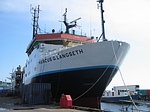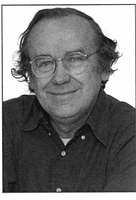New R/V Langseth named after Marcus Gerhardt Langseth, (1932-1997)
Lamont-Doherty Earth Observatory’s first ship was the R/V Vema, acquired in 1952. She was succeeded by the Robert D. Conrad, the Eltanin, and the Maurice Ewing. But today’s requirements for a seismic research vessel are greater than ever before. Several years ago the search began for a new vessel that could meet the new demands. Western Legend, a commercial seismic exploration vessel owned by Western Geco, Inc., turned out to be the ideal candidate.
The National Science Foundation provided funding of more than $20 million to support the purchase and refit of Western Legend, which, after a year-long outfitting with modern laboratories and scientific equipment, will become the most capable academic research vessel utilizing acoustic and seismic technologies in the world. Newly created laboratory spaces will be substantially superior to those available on the Ewing, and deck space configurations will be able to be optimized for ocean-bottom seismometer operations or general oceanography.
The new vessel will be able to tow four 6-kilometer-long streamers. It will be equipped to carry out two- and three-dimensional imaging of the ocean floor and the Earth’s deep interior. These seismic cross-sections, like medicine’s CAT scans and sonograms, will enable us to peer directly into the Earth. Even better, because the receiving systems used by the new vessel to record the sounds that probe the Earth’s interior are substantially more sophisticated than those found on board the Ewing, the Langseth’s greatly improved imaging capabilities will not come at a cost of increased sound levels transmitted into the ocean, thus minimizing possible impacts upon marine life.
What this exciting new research vessel will allow us to learn about seafloor spreading, earthquakes, magma flow, gas hydrate deposits, continental drift, and more, will expand scientific knowledge about the Earth and contribute to our ability as humans to withstand its extreme forces.
The vessel has been renamed the Marcus G. Langseth, in honor of the late Lamont scientist, who moved to Palisades with his wife Lillian in 1980.
Marcus G. Langseth (Mark to his friends) started at Lamont Geological Observatory in 1953 as a summer hired hand. He had grown up mostly in orphanages, but his intellect and tenacity led him to graduate with a bachelor’s degree from Waynesburg College, and a doctorate from Columbia University. Only twelve men have walked on the moon. Six of them brought Mark’s equipment along.
At Lamont in the late 1950s and early 1960s, he developed one of the first instruments to measure the heat flux between the interior of the Earth and the deep ocean basins. Working with Dick Von Herzen of the Woods Hole Oceanographic Institution, he compiled the first global heat flow map — a map that was instrumental in establishing the emerging paradigms of plate tectonics and sea floor spreading.
As chief scientist of the Apollo Heat Flow Experiment, his measurements showed that the moon had lost much of its internal heat long ago, and that it lacked the Earth’s mechanisms for creating new heat. In recognition of this very important contribution to our understanding of the moon, he received NASA’s Special Achievement Award.
Mark played a key leadership role in the Ocean Drilling Program, and chaired national committees that oversee the academic research vessel fleet. In the 1990s he was the scientific leader that enabled the first unclassified scientific mission aboard a U.S. Navy nuclear‑powered submarine operating beneath the Arctic ice cap. The resulting data have revolutionized our understanding of the Arctic Ocean.
Beyond these and other scientific contributions too numerous to list here, Mark was a kind and gentle person, and a beloved mentor to many Lamont staff and students. Lamont is proud that its new research vessel bears the name “Marcus G. Langseth.”
G. Michael Purdy, Director of Lamont-Doherty Earth Observatory, summed it up best when he said, simply, “The purchase of this new ship is the beginning of a new era in Lamont ship operations.”
(This article used information from a Lamont presentation on the new ship.)



